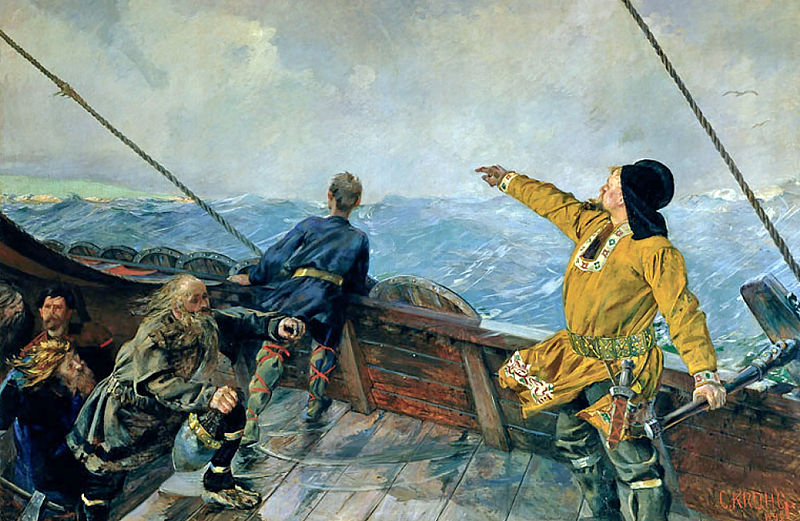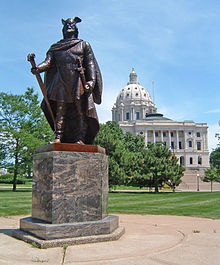Traveling within the World
Linking your favorite traveling artists across the globe
Leif Eriksson..The Viking by tuffy perkins

Leif Eriksson was the son of Erik the Red, founder of the first European settlement on what is now called Greenland. Around A.D. 1000, Eriksson sailed to Norway, where King Olaf I converted him to Christianity. According to one school of thought, Eriksson sailed off course on his way back to Greenland and landed on the North American continent, where he explored a region he called Vinland. He may also have sought out Vinland based on stories of an earlier voyage by an Icelandic trader. After spending the winter in Vinland, Leif sailed back to Greenland, and never returned to North American shores. He is generally believed to be the first European to reach the North American continent, nearly four centuries years before Christopher Columbus arrived in 1492.
Christianity
Leif Eriksson (spelling variations include Eiriksson, Erikson or Ericson), known as "Leif the Lucky," was the second of three sons of the famed Norse explorer Erik the Red, who established a settlement in Greenland after being expelled from Iceland around A.D. 980. The date of Leif Eriksson's birth is uncertain, but he is believed to have grown up in Greenland.
According to the 13th-century Icelandic Eiriks saga (or "Saga of Erik the Red"), Eriksson sailed from Greenland to Norway around 1000. On the way, he was believed to have stopped in the Hebrides, where he had a son, Thorgils, with Thorgunna, daughter of a local chief. In Norway, King Olaf I Tryggvason converted Eriksson to Christianity, and a year later sent him back to Greenland with a commission to spread the faith among the settlers there.
Eriksson's Voyage to Vinland
Historical accounts differ on the subsequent events. According to the Eiriks saga, Eriksson sailed off course on his return to Greenland and landed on the North American continent. He called the region where he landed Vinland after the wild grapes that grew in abundance there and the general fertility of the land. Another Icelandic saga, the Groenlendinga saga (or "Saga of the Greenlanders"), which scholars consider more reliable that the Eiriks saga, holds that Leif Eriksson heard about Vinland from the Icelandic trader Bjarni Herjulfsson, who had sighted the North American continent from his ship 14 years before Leif's voyage but not set foot on land.
Eriksson's Later Life in Greenland and Legacy
After his time in Vinland, Eriksson returned to Greenland, and he would never return to North American shores. Though his father proved unreceptive to the Christian faith, Leif was able to convert his mother, Thjodhild, who had Greenland's first Christian church built at Brattahild. When Erik the Red died, Leif Eriksson took over as chief of the Greenland settlement. His son Thorgils was sent by his mother (whom Leif never married) to live in Greenland, but was apparently unpopular. Another (presumably legitimate) son, Thorkel Leifsson, became chief by 1025, after his father's death. Nothing further is known about Leif's descendants.
Beginning in the late 19th century, many Nordic Americans celebrated Leif Eriksson as the first European explorer of the New World. In 1925, in honor of the 100th anniversary of the arrival of the first official group of Norwegian immigrants in the United States, President Calvin Coolidge announced to a Minnesota crowd that Eriksson had been the first European to discover America. And in September 1964, Congress approved a public resolution that authorized President Lyndon B. Johnson to declare October 9 as "Leif Eriksson Day.
" 
Tags:
Replies to This Discussion
Events
-
2014 is the Chinese Year of the Horse
February 17, 2026 at 12am to February 5, 2027 at 12am – where & how you choose
Birthdays
Birthdays Tomorrow
Important (read & understand)
Skype: Travelingraggyman
Email and Instant Messenger:
TravelerinBDFSM @ aol/aim; hotmail; identi.ca; live & yahoo
OR
Travelingraggyman @ gmail and icq ***

1AWARD UPDATES & INFORMATION
10,000 votes - Platinum Award
5,000 votes - Gold Award
2,500 votes - Silver Award
1,000 votes - Bronze Award
300 votes - Pewter Award
100 votes - Copper Award
Member of the Associated Posting System {APS}
This allows members on various sites to share information between sites and by providing a by line with the original source it credits the author with the creation.
Legal Disclaimer
***************We here at Traveling within the World are not responsible for anything posted by individual members. While the actions of one member do not reflect the intentions of the entire social network or the Network Creator, we do ask that you use good judgment when posting. If something is considered to be inappropriate it will be removed
Site Meter
This site is strictly an artist operational fan publication, no copyright infringement intended
Patchwork Merchant Mercenaries had its humble beginnings as an idea of a few artisans and craftsmen who enjoy performing with live steel fighting. As well as a patchwork quilt tent canvas. Most had prior military experience hence the name.
Patchwork Merchant Mercenaries.
Vendertainers that brought many things to a show and are know for helping out where ever they can.
As well as being a place where the older hand made items could be found made by them and enjoyed by all.
We expanded over the years to become well known at what we do. Now we represent over 100 artisans and craftsman that are well known in their venues and some just starting out. Some of their works have been premiered in TV, stage and movies on a regular basis.
Specializing in Medieval, Goth , Stage Film, BDFSM and Practitioner.
Patchwork Merchant Mercenaries a Dept of, Ask For IT was started by artists and former military veterans, and sword fighters, representing over 100 artisans, one who made his living traveling from fair to festival vending medieval wares. The majority of his customers are re-enactors, SCAdians and the like, looking to build their kit with period clothing, feast gear, adornments, etc.
Likewise, it is typical for these history-lovers to peruse the tent (aka mobile store front) and, upon finding something that pleases the eye, ask "Is this period?"
A deceitful query!! This is not a yes or no question. One must have a damn good understanding of European history (at least) from the fall of Rome to the mid-1600's to properly answer. Taking into account, also, the culture in which the querent is dressed is vitally important. You see, though it may be well within medieval period, it would be strange to see a Viking wearing a Caftan...or is it?
After a festival's time of answering weighty questions such as these, I'd sleep like a log! Only a mad man could possibly remember the place and time for each piece of kitchen ware, weaponry, cloth, and chain within a span of 1,000 years!! Surely there must be an easier way, a place where he could post all this knowledge...
Traveling Within The World is meant to be such a place. A place for all of these artists to keep in touch and directly interact with their fellow geeks and re-enactment hobbyists, their clientele.
© 2025 Created by Rev. Allen M. Drago ~ Traveler.
Powered by
![]()